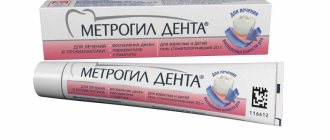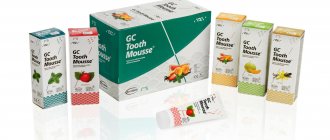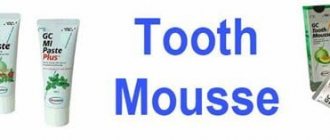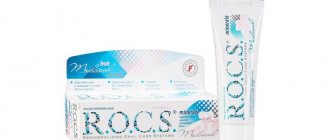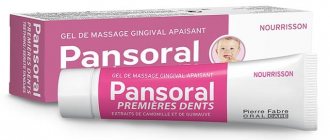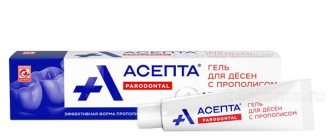Gum inflammation is accompanied by a number of painful symptoms that not only affect your well-being, but also affect your ability to chew and speak normally. To eliminate unpleasant signs in dentistry, special gels are used. They act directly on the oral mucosa and are slightly absorbed into the blood, which makes them safe for children.
Painkillers and anti-inflammatory gels can be used during teething (Baby Doctor) and for complex treatment of gingivitis or stomatitis.
Indications for use of dental gels
The dentist may prescribe the gel to a child or adult when there are signs of gum inflammation. The reason for using the gel will also be stomatitis, which affects not only the gums, but also the entire oral mucosa.
Dental gel will help with the following symptoms and diseases:
- pain, burning, redness along the edge of the tooth crown;
- bleeding gums after chewing hard foods and brushing teeth;
- thrush, fungal stomatitis or oral candidiasis;
- glossitis (inflammation of the tongue) and papillitis (inflammation of the dental papilla);
- teething in a child;
- growth of wisdom teeth, which is accompanied by gum damage.
The medicine can only be used topically. The gel is applied to the affected areas of the mucous membrane up to 4 times a day, according to the instructions. After treating the gums, it is recommended not to eat anything for several hours, and not to drink for at least half an hour, so as not to wash off the drug. Before applying, be sure to rinse your mouth with an antiseptic or regular mouthwash.
Some types of gels are homeopathic remedies, therefore, in case of severe inflammation and pain they will be ineffective (Malavit), others have a strong anti-inflammatory and analgesic effect. There is a large selection of dental gels; it is important to understand how they differ, and which one is better for a particular problem.
Dentamet gel stomat 25 g pack of cards x1
Dentamet gel stomat 25 g pack of cards x1
Composition per 100 g of gel:
Active ingredients: metronidazole - 1.00 g, chlorhexidine digluconate solution 20% - 0.50 g in terms of chlorhexidine digluconate - 0.10 g
Excipients: levomenthol (L-Menthol) - 0.25 g, glycerol (glycerin) - 5.00 g, propylene glycol - 5.00 g, trolamine (thermostable triethanolamine) - 0.47 g, carbomer - 1.25 g, sodium saccharinate dihydrate - 0.25 g, purified water - 86.28 g
Description
Homogeneous gel, from white to white with a yellowish tint.
Pharmacodynamics
Combined antimicrobial drug. The effectiveness of the drug is due to the presence of active ingredients in its composition, such as metronidazole and chlorhexidine.
Metronidazole is a nitroimidazole derivative that has antiprotozoal and antibacterial effects against anaerobic protozoa and anaerobic bacteria that cause periodontal diseases: Porphyromonas gingivalis, Prevotella intermedia, Prevotella denticola, Fusobacterium fusiformis, Wolinella recta, Treponema spp., Eikenella corrodens, Borrelia vincenti, Bact eroides melaninogenicus, Selenomonas spp. Inactive against aerobic bacteria. The mechanism of action is the biochemical reduction of the 5-nitro group of metronidazole by intracellular transport proteins of anaerobic microorganisms and protozoa. The reduced 5-nitro group of metronidazole interacts with the DNA of microbial cells, inhibiting the synthesis of their nucleic acids, which leads to the death of bacteria.
Chlorhexidine is an antiseptic, has a bactericidal effect against gram-positive and gram-negative bacteria, and has a fungicidal and virucidal effect (against lipophilic viruses). It affects bacterial spores only at elevated temperatures. Effective against gram-positive and gram-negative bacteria (including (Treponema spp., Neisseria gonorrhoeae, Chlamidia spp.)), viruses and fungi.
Pharmacokinetics
When applied topically, the active substances are practically not subject to systemic absorption and do not have a systemic effect.
Indications
Infectious and inflammatory diseases of periodontal and oral mucosa:
- acute and chronic gingivitis,
— acute ulcerative-necrotizing gingivitis of Vincennes,
- acute and chronic periodontitis,
- periodontal disease complicated by gingivitis,
- aphthous stomatitis,
- cheilitis,
- inflammation of the oral mucosa when wearing dentures,
- post-extraction alveolitis (inflammation of the socket after tooth extraction),
- periodontitis, periodontal abscess (as part of combination therapy).
Contraindications
- hypersensitivity to metronidazole, chlorhexidine, nitroimidazole derivatives or other components of the drug,
- diseases of the blood system, including a history of
- diseases of the peripheral and central nervous system,
- children under 18 years of age.
Use during pregnancy and breastfeeding
Due to the lack of clinical data, the safety of the drug during pregnancy and breastfeeding has not been established. The use of the drug during pregnancy is not recommended. During the period of breastfeeding, if it is necessary to prescribe the drug, the issue of stopping breastfeeding should be decided.
Directions for use and doses
Topically, for dental use only.
For inflammation of the gums (gingivitis):
Dentamet is applied to the gum area with a thin layer with your finger or with a cotton swab 2 times a day. After applying the gel, you should refrain from drinking and eating for 30 minutes. It is not recommended to wash off the gel. The duration of treatment is on average 7-10 days.
For periodontitis:
After removing dental plaque, periodontal pockets are treated with Dentamet gel, and the gel is applied to the gum area. Exposure time - 30 minutes. The number of procedures depends on the severity of the disease. In the future, the patient can apply the gel independently. Dentamet is applied to the gum area 2 times a day for 7-10 days.
For aphthous stomatitis:
Dentamet is applied to the affected area of the oral mucosa 2 times a day for 7-10 days.
To prevent exacerbations of chronic gingivitis and periodontitis:
Dentamet is applied to the gum area 2 times a day for 7-10 days. Preventive courses of treatment are carried out 2-3 times a year.
To prevent post-extraction alveolitis:
After tooth extraction, the hole is treated with Dentamet gel, then the gel is applied 2-3 times a day for 7-10 days.
Cautions, therapy monitoring
Avoid contact with eyes.
The use of Dentamet gel does not replace hygienic brushing of teeth, therefore, during the course of treatment with the drug, brushing should be continued.
The drug should be stored out of the reach of children. If the drug is accidentally or intentionally swallowed by a child, seek immediate medical attention.
Impact on the ability to drive vehicles and operate machinery
No data on negative effects.
Side effects
When using Dentamet gel topically, the following may sometimes be observed: a “metallic” taste in the mouth, headache, allergic reactions (skin rash, itching, urticaria, anaphylactic reactions, including anaphylactic shock).
If any of the side effects indicated in the instructions get worse, or you notice other side effects not listed in the instructions, tell your doctor.
Overdose
There were no cases of drug overdose with topical use.
Interaction
When applied topically in recommended doses, no systemic interaction of Dentamet gel with other drugs was detected.
Storage conditions and periods
Storage conditions:
At a temperature not higher than 25 ºС.
Keep out of the reach of children.
Best before date:
2 years.
Do not use after the expiration date stated on the packaging.
,
,
Which gel is better?
A well-known representative is Dental. This is an anti-inflammatory gel; it contains corn oil, which promotes the formation of a protective barrier on the mucous membrane, which allows damaged cells to recover faster and prevent complications.
It is recommended to use Dental up to 4 times a day, applying it in a thin layer to the entire surface of the inflamed gum. This drug will also help those who are faced with denture stomatitis. The drug accelerates regeneration, reduces inflammation and relieves pain.
Parodium is another good remedy for inflammatory diseases of the oral mucosa. It is both an antiseptic and has an anti-inflammatory and hemostatic effect. Indicated for the treatment of periodontitis, gingivitis, traumatic and bacterial stomatitis.
Kalgel and Baby Doctor are one of the safest products for children during teething. They relieve pain, cool the gums, and begin to act almost instantly. Their only drawback is the short duration of pain relief; they can relieve unpleasant symptoms for up to 30 minutes.
The most well-known representatives, which are most often recommended by dentists, are the gels Metrogyl Denta, Asepta, Cholisal, Solcoseryl and Kamistad.
Metrogil Denta
Contains an antibacterial substance - metronidazole and an antiseptic - chlorhexidine. It is used to relieve gum pain during stomatitis, after dental treatment, during an inflammatory process due to infection or traumatic injury.
The gel is practically not absorbed, therefore it is safe for treating the oral mucosa of a child. But at the same time, the low concentration of the active ingredient makes it not the most effective against severe inflammation; after treatment, there may be a relapse.
Solcoseryl
One of the most popular gels in dentistry is Solcoseryl. This remedy is classified as a medicine (while many others act as balms), therefore it is recommended by dentists for the treatment of such unpleasant pathologies as oral candidiasis, viral, traumatic and necrotizing ulcerative stomatitis.
Solcoseryl gel will help get rid of pain; the active ingredients in its composition stimulate metabolic processes in the affected tissues, which accelerates regeneration.
Dentamet
Dentamet gel stomat 25 g pack of cards x1
Composition per 100 g of gel:
Active ingredients: metronidazole - 1.00 g, chlorhexidine digluconate solution 20% - 0.50 g in terms of chlorhexidine digluconate - 0.10 g
Excipients: levomenthol (L-Menthol) - 0.25 g, glycerol (glycerin) - 5.00 g, propylene glycol - 5.00 g, trolamine (thermostable triethanolamine) - 0.47 g, carbomer - 1.25 g, sodium saccharinate dihydrate - 0.25 g, purified water - 86.28 g
Description
Homogeneous gel, from white to white with a yellowish tint.
Pharmacodynamics
Combined antimicrobial drug. The effectiveness of the drug is due to the presence of active ingredients in its composition, such as metronidazole and chlorhexidine.
Metronidazole is a nitroimidazole derivative that has antiprotozoal and antibacterial effects against anaerobic protozoa and anaerobic bacteria that cause periodontal diseases: Porphyromonas gingivalis, Prevotella intermedia, Prevotella denticola, Fusobacterium fusiformis, Wolinella recta, Treponema spp., Eikenella corrodens, Borrelia vincenti, Bact eroides melaninogenicus, Selenomonas spp. Inactive against aerobic bacteria. The mechanism of action is the biochemical reduction of the 5-nitro group of metronidazole by intracellular transport proteins of anaerobic microorganisms and protozoa. The reduced 5-nitro group of metronidazole interacts with the DNA of microbial cells, inhibiting the synthesis of their nucleic acids, which leads to the death of bacteria.
Chlorhexidine is an antiseptic, has a bactericidal effect against gram-positive and gram-negative bacteria, and has a fungicidal and virucidal effect (against lipophilic viruses). It affects bacterial spores only at elevated temperatures. Effective against gram-positive and gram-negative bacteria (including (Treponema spp., Neisseria gonorrhoeae, Chlamidia spp.)), viruses and fungi.
Pharmacokinetics
When applied topically, the active substances are practically not subject to systemic absorption and do not have a systemic effect.
Indications
Infectious and inflammatory diseases of periodontal and oral mucosa:
- acute and chronic gingivitis,
— acute ulcerative-necrotizing gingivitis of Vincennes,
- acute and chronic periodontitis,
- periodontal disease complicated by gingivitis,
- aphthous stomatitis,
- cheilitis,
- inflammation of the oral mucosa when wearing dentures,
- post-extraction alveolitis (inflammation of the socket after tooth extraction),
- periodontitis, periodontal abscess (as part of combination therapy).
Contraindications
- hypersensitivity to metronidazole, chlorhexidine, nitroimidazole derivatives or other components of the drug,
- diseases of the blood system, including a history of
- diseases of the peripheral and central nervous system,
- children under 18 years of age.
Use during pregnancy and breastfeeding
Due to the lack of clinical data, the safety of the drug during pregnancy and breastfeeding has not been established. The use of the drug during pregnancy is not recommended. During the period of breastfeeding, if it is necessary to prescribe the drug, the issue of stopping breastfeeding should be decided.
Directions for use and doses
Topically, for dental use only.
For inflammation of the gums (gingivitis):
Dentamet is applied to the gum area with a thin layer with your finger or with a cotton swab 2 times a day. After applying the gel, you should refrain from drinking and eating for 30 minutes. It is not recommended to wash off the gel. The duration of treatment is on average 7-10 days.
For periodontitis:
After removing dental plaque, periodontal pockets are treated with Dentamet gel, and the gel is applied to the gum area. Exposure time - 30 minutes. The number of procedures depends on the severity of the disease. In the future, the patient can apply the gel independently. Dentamet is applied to the gum area 2 times a day for 7-10 days.
For aphthous stomatitis:
Dentamet is applied to the affected area of the oral mucosa 2 times a day for 7-10 days.
To prevent exacerbations of chronic gingivitis and periodontitis:
Dentamet is applied to the gum area 2 times a day for 7-10 days. Preventive courses of treatment are carried out 2-3 times a year.
To prevent post-extraction alveolitis:
After tooth extraction, the hole is treated with Dentamet gel, then the gel is applied 2-3 times a day for 7-10 days.
Cautions, therapy monitoring
Avoid contact with eyes.
The use of Dentamet gel does not replace hygienic brushing of teeth, therefore, during the course of treatment with the drug, brushing should be continued.
The drug should be stored out of the reach of children. If the drug is accidentally or intentionally swallowed by a child, seek immediate medical attention.
Impact on the ability to drive vehicles and operate machinery
No data on negative effects.
Side effects
When using Dentamet gel topically, the following may sometimes be observed: a “metallic” taste in the mouth, headache, allergic reactions (skin rash, itching, urticaria, anaphylactic reactions, including anaphylactic shock).
If any of the side effects indicated in the instructions get worse, or you notice other side effects not listed in the instructions, tell your doctor.
Overdose
There were no cases of drug overdose with topical use.
Interaction
When applied topically in recommended doses, no systemic interaction of Dentamet gel with other drugs was detected.
Storage conditions and periods
Storage conditions:
At a temperature not higher than 25 ºС.
Keep out of the reach of children.
Best before date:
2 years.
Do not use after the expiration date stated on the packaging.
,
,
